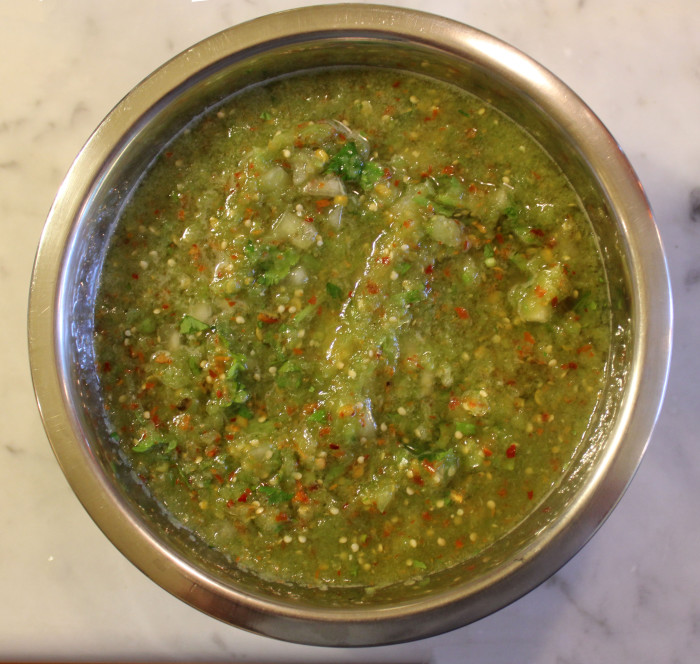This is Suzen’s favorite tomatillo salsa, bright and intense. Tomorrow, I’ll post a cooked tomatillo salsa, the one I prefer, for it seems to have a deeper, more complex flavor. But, I’m happy to eat either one. So is Suzi. And so will you.
If you search, you’ll find dozens of recipes for tomatillo salsa using raw, and not cooked, fruit. Most of these recipes use jalapeno or serrano chiles. I’m using arbols here: small, red fire bombs. They provide those red flakes of color you see in the photo and the heat you will taste. Lots of heat. I made this using 10 dried chiles and I would not add one more. You may wish to back off a bit right at the start and use, say, only 6.
The next day, this salsa is significantly hotter. So hot, that while she was still in love with it, Suzen could not eat it. We mixed the leftovers of this uncooked salsa with the leftovers of tomorrow’s cooked one. That marriageaffords incredible flavor complexity and color.
Tomatillos do contain lots of pectin. On Day 2, the pectin may have taken effect and the salsa may become very thick with an almost custard consistency. Just add a tablespoon or two of hot water and stir to loosen the salsa. The flavor will not be noticeably affected, but it will now be very dip-able.
You can make infinite adjustments to this recipe. If you are cilantro-sensitive, you can back off the amount to just a tablespoon. Cumin or chile powder can be added in the amounts you desire. Don’t forget the cardinal rule of added hot components: you can add but subtracting is difficult!
Brian's Uncooked Tomatillo Salsa Verde
Yield: 2-3 cups
Ingredients:
- 6-10 dried arbol chiles
- 2 large garlic cloves, peeled and diced
- 12 ounces tomatillos, husked and rinsed
- ½ cup finely diced onion, preferably sweet
- ½ cup finely chopped cilantro
- Juice of 1 lime, added ½ lime at a time
- Salt
- 1 tablespoon sugar, optional
- 1 tablespoon white wine vinegar, optional
Preparation:
Place the dried arbol chiles in a bowl of hot water and allow to soften. They will become flexible but not at all mushy. Place the chiles and the garlic in a blender and pulse. The chiles will fragment and fly all over the inside of the blender. Use a spatula to rearrange these pieces towards the bottom of the blender.
Place the blended mixture in a glass bowl. Add the onion, cilantro, juice of ½ lime and stir to mix. Add a little salt and taste test.
Because of the arbols, this salsa will be hot. You can now add some additional lime juice, some sugar, or the wine vinegar to adjust the flavor balance and the relative heat.
You can serve this salsa immediately or refrigerate until another day. On subsequent days, the salsa will become hotter and you may seek adjust with additional sugar to temper the heat.
Source: Brian O’Rourke
Photo Information: Canon T2i, EFS 60mm Macro Lens, F/4 for1/30th second at ISO‑800

